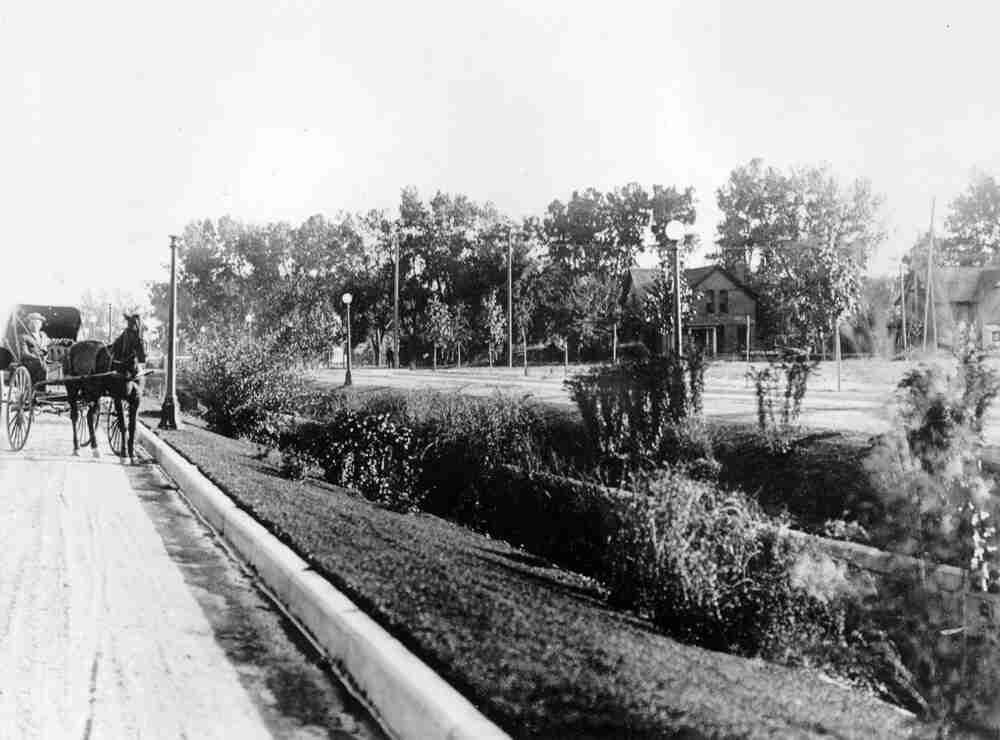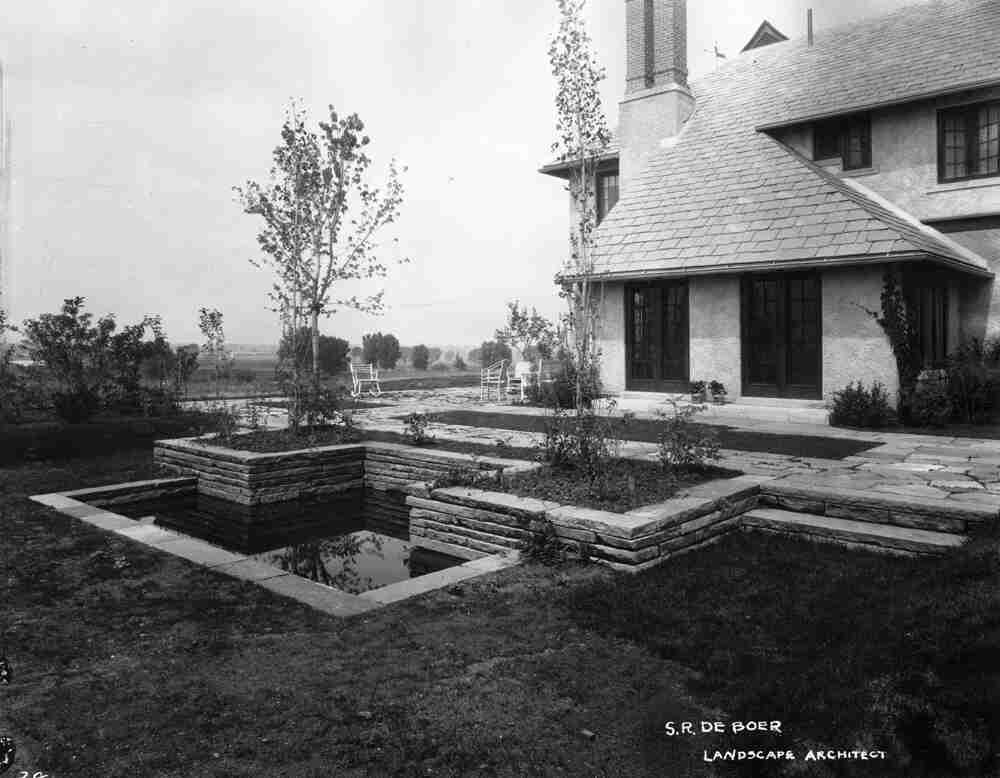Saco Rienk DeBoer
Full Article
Saco Rienk DeBoer (1883–1974) was a prolific Denver-based landscape architect and city planner in the early twentieth century. DeBoer played a significant role in the development of Denver’s built environment, particularly the city’s parks and the establishment of its zoning codes. His work remains visible today in places such as City Park, and Washington Park, and along Cherry Creek, as well as in the suburban communities of Cherry Hills, Greenwood Village, and Lakewood.
Born in Ureterp, province of Friesland, the Netherlands, in 1883, Saco Rienk DeBoer lived with his father, an architect, who encouraged his son’s dream of becoming an engineer and building bridges across deep gorges in the Swiss Alps. After high school a young DeBoer left home for engineering school, where he studied industriously for three years. But when he began coughing and spitting up blood, he had to return home and continue his studies there. DeBoer passed a government surveying examination only to find himself number 18 on a list of 150 candidates for fifteen government jobs.
On the advice of his doctor, DeBoer left engineering and began studying landscape design. First he studied botany in Holland and then, in 1903, enrolled in the Royal Imperial School of Horticulture in southern Germany. However, after two more years his tuberculosis forced him to again return home to complete his studies. He also studied architecture, taking a course with a leading architect and working with his father on architectural projects. In 1907 he opened his own landscaping office in Ureterp.
Move to Colorado
The following year DeBoer became severely ill, bleeding in his lungs. His doctor advised him that he was suffering from tuberculosis and did not have long to live. His family, having heard of the healthful climates of Colorado and New Mexico, decided to move to the American west. Within a few months the family was settled in Denver, where DeBoer lived to the age of ninety-one. In later years, he would chuckle about the doctors who had told him he would be lucky to reach forty.
But in America DeBoer found ugliness. He saw that in America, cities had been thrown up when there was no time or talent available to make careful plans, built according to a standardized pattern that had neither utility nor beauty. “City after city,” he lamented, “occurs until one continuous, monotonous Main Street seems to stretch from Atlantic to Pacific, from the Gulf to the Arctic.” DeBoer sought to enliven American streets by planting shade trees and flowers and by carefully planning future expansions to avoid chaotic, ugly clutter. This task would not be easy, as plant species that flourished in Holland and Germany might not grow at all in such a dry climate, and successful cultivation methods in Europe could fail in the arid American west.
Sometimes DeBoer had trouble with his experimental tree plantings. He put in hackberries along two blocks of Marion Street Parkway; they leafed out nicely and grew all summer. The following winter, however, they died. Upon checking, DeBoer discovered that the hackberries had come from the lowlands of Mississippi and could not be expected to withstand Denver’s cold climate. He ordered a hardier variety, Celtis occidentalis. He and a helper pulled up the dead Mississippi trees and replaced them with new ones, which are still there today.
At times it was hard for DeBoer to make improvements that he deemed necessary, as he found out in City Park. Well-meaning private citizens and schoolchildren had planted the west end of the park in the 1890s, resulting in a dense maze of circular roads, S-shaped walks, and large trees with no open spaces to provide relief and distance. When DeBoer began removing some of the trees, there was such a public outcry that he completed the work during snowstorms to avoid criticism. However, when the big sloping lawns appeared, Denver citizens stopped complaining and turned out en masse to enjoy them.
Changing with the Times
As automobile use increased in Denver, DeBoer soon realized that parks and cars do not mix. Winding roads had always been a feature of public parks in horse-and-buggy days. But that was all changing as automobiles became more popular. DeBoer thought that traffic should be routed around parks on perimeter roads and that traffic would serve a secondary purpose: if motorists were kept out of the parks but given brief glimpses of hidden delights through the foliage, it would stir their senses and whet their appetites. DeBoer’s plans for new Denver parks thus did not include many interior roads. He opened up Twenty-Third Avenue and widened Seventeenth Avenue to keep traffic out of City Park, and surrounded the huge lawn he planted in Washington Park with posts to keep motorists out.
He was still working in Washington Park when Mayor Robert Speer, a supporter of DeBoer’s designs, left office in 1912. The new administration stopped all work on the park. DeBoer had already brought in trees for the north end, so he planted them anyway. Evergreen Hill is the result of his disobedience.
DeBoer was elated when Speer was reelected in 1916, but he received a letter from W.F.R. Mills, manager of improvement and parks, telling DeBoer that his services were no longer required. It was a crushing blow to DeBoer, who began to consider opening a private landscaping business. Once Speer learned of the firing, he immediately rehired DeBoer and chastised Mills, though DeBoer would never forget the unsettling experience. He opened a landscape office in the Tramway Building in 1919. His partner, Walter Pesman, worked there full-time while DeBoer continued his work for the city.
In 1922 DeBoer went to Europe for a few months to study with Thomas Mawson of Lancaster, England, one of the most renowned city planners in the world. DeBoer was disappointed to find that Mawson’s designs did not allow for the kind of spaciousness and integrated park-city planning that DeBoer had been doing in Denver. DeBoer toured city after city and returned to Denver with a notebook overflowing with ideas from European city planning.
City Planning
In 1923 Benjamin F. Stapleton became mayor of Denver and DeBoer was pleased, believing him to be the logical successor to Speer. Urban planning, city renewal, parks, and parkways once more became important items at city hall. Stapleton wanted Denver to be as beautiful as any other American city, so when he went to Washington one spring and saw the flowering cherries in bloom, he knew that Denver had to have cherry trees. The parks department dutifully planted some, only to have them freeze the following winter. They tried again, with the same results. Then DeBoer had an idea to try the flowering purple Japanese crabapple tree, and planted several along Marion Street Parkway and Cherry Creek. They survived, and in a couple years produced beautiful pinkish-red flowers. Denver fell in love with the trees and many people planted them in their front yards and gardens.
Stapleton and DeBoer were both committed to careful city planning. As the 1920s wore on, they knew that Denver had to adopt zoning, of which DeBoer was an outspoken advocate. Stapleton appointed DeBoer as an inaugural member of Denver’s first zoning commission in 1925. The commission drew up a zoning ordinance, which was promptly adopted.
Over the years Denver and DeBoer developed a reciprocal friendship: DeBoer learned from the city’s failures and successes, while Denver benefited from DeBoer’s work and ideas. DeBoer advocated for industries, particularly Denver’s packing houses and glue factories, to be placed so that prevailing winds would blow smoke and odors away from the residential and commercial sections of the city. He also believed that homes in residential districts should be located around open parks and that residential streets should be pleasantly curved and planted, with through-traffic discouraged so children could safely play in the street. DeBoer held that traffic arteries should skirt the edges of these areas, making the neighborhoods quiet but accessible.
DeBoer got a chance to implement one of his ideal neighborhood plans in the suburb of Lakewood. Cyrus Creighton, a farmer with eighty acres west of Denver, employed DeBoer to subdivide his land. DeBoer designed a beautiful residential park featuring curved streets and plenty of greenery—Denver’s first landscaped subdivision. DeBoer also worked in the Cherry Hills Country Club area, drawing the master plans for Cherry Hills Village and Greenwood Village.
Later Life
Although DeBoer and his partner Pesman had plenty of work, their business records showed a continual loss, so in 1924 they dissolved their partnership. The same year DeBoer opened a new office, S.R. DeBoer & Company, City Planners and Landscape Architects, next to his family home at 515 East Iliff Avenue. Other cities profited from DeBoer’s ideas as well. In 1926 Grand Junction employed him to develop its master urban plan. The plan received wide attention and led in 1930 to his planning of Boulder City, Nevada, at the site of the future Hoover Dam.
A firm advocate of botanical gardens, in 1941 DeBoer became the Botanic Garden committee chairman for the Colorado State Forestry Association, which resolved to establish Denver’s Botanic Gardens. In 1951 the city accepted DeBoer’s plans for the Denver Botanic Gardens, eventually realized in its present location at York Street and East Ninth Avenue. Defying the predictions of his Dutch physicians early in his life, DeBoer lived a productive ninety-nine years before he passed away in Denver in 1974.
Adapted from Joyce Summers, “One Man’s Vision: Saco Rienk DeBoer, Denver’s Landscape Architect,” Colorado Heritage Magazine 8, no. 2 (1988).




